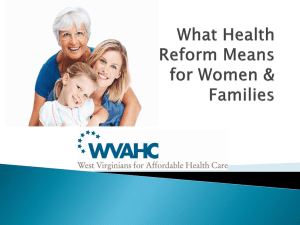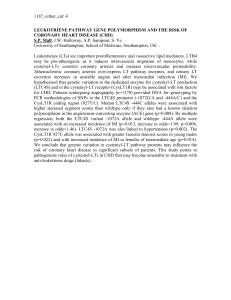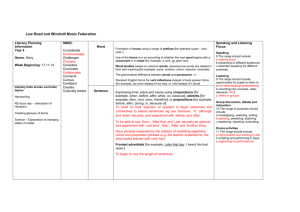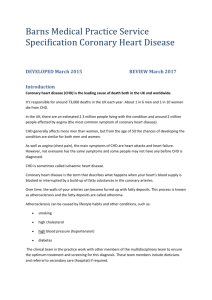Model Building, logistic regression
advertisement
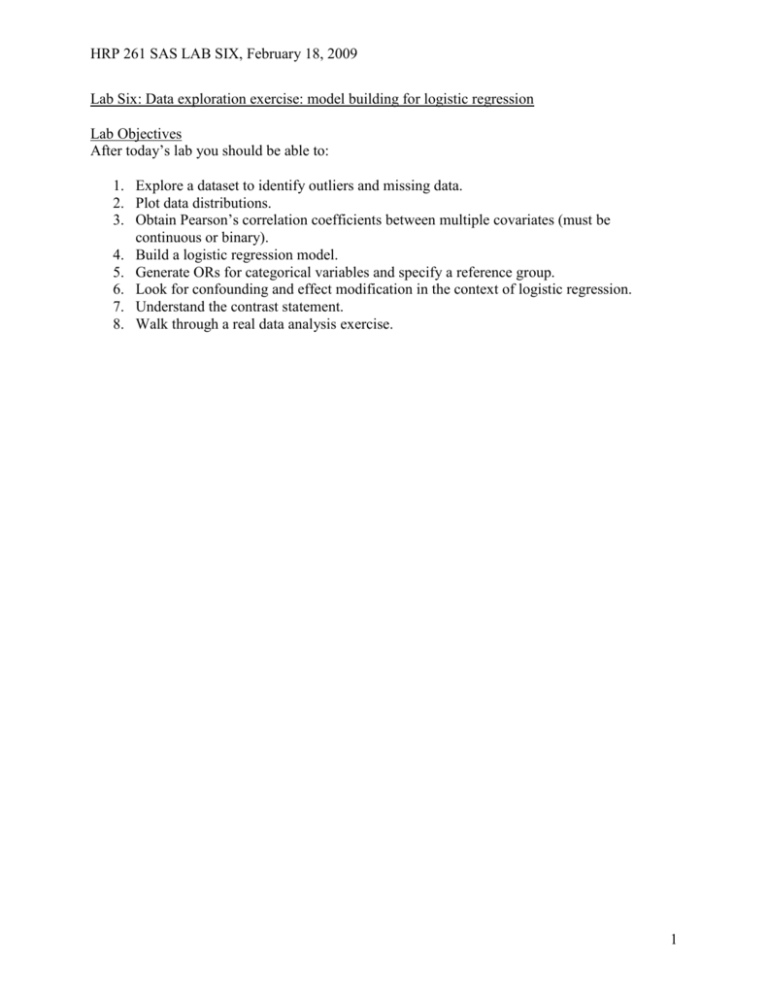
HRP 261 SAS LAB SIX, February 18, 2009 Lab Six: Data exploration exercise: model building for logistic regression Lab Objectives After today’s lab you should be able to: 1. Explore a dataset to identify outliers and missing data. 2. Plot data distributions. 3. Obtain Pearson’s correlation coefficients between multiple covariates (must be continuous or binary). 4. Build a logistic regression model. 5. Generate ORs for categorical variables and specify a reference group. 6. Look for confounding and effect modification in the context of logistic regression. 7. Understand the contrast statement. 8. Walk through a real data analysis exercise. 1 HRP 261 SAS LAB SIX, February 18, 2009 LAB EXERCISE STEPS: Follow along with the computer in front… 1. Download the LAB 6 DATA (chd) from the class website (already in SAS format!). www.stanford.edu/~kcobb/courses/hrp261 right click on LAB 6 DATAsave to desktop This dataset contains data from an unmatched case-control study of 160 chd cases (heart disease) and 302 controls. Participants were queried about their medical status and personal habits one year ago (prior to the onset of heart disease for cases). Outcome variable: CHD—heart disease, yes/no (1/0) Predictor variables: Age—years Tobacco—cigarettes/day Alcohol—ounces/day Adiposity—percent body fat BMI—normal weight, overweight, or obese according to BMI (character variable) Sbp—blood pressure LDL—LDL cholesterol FamHist—Family history of heart disease (1/0) Typea—Score on a test of type A personality (higher score means more Type A) The purpose of the study was to test whether alcohol and tobacco are related to heart disease controlling for potential confounders. 2. Use point-and-click features to create a permanent library that points to the desktop (where the datasets are sitting): a. Click on “new library” icon (slamming file cabinet on the toolbar). b. Browse to find your desktop. c. Name the library lab6. d. Hit OK to exit and save. 3. Use your explorer browser to find the lab6 library and verify that you have a SAS dataset in there: chd. 4. Use the interactive data analysis features to check the variables in the dataset chd: a. From the menu select: SolutionsAnalysisInteractive Data Analysis b. Double click to open: library “lab6”, dataset “chd” c. Highlight “sbp” variable from the menu select: AnalyzeDistribution(Y) d. Repeat for the other variables. e. What things do you notice? f. What’s your sample size? How many men have chd? 2 HRP 261 SAS LAB SIX, February 18, 2009 g. What variables are correlated with chd? 5. Check for correlations among the variables in your chd dataset: proc corr data=lab6.chd best=5; var sbp tobacco ldl adiposity famhist typea alcohol age; run; To limit the output, the “best=k” option asks for the k highest correlation coefficients for each variable (including its correlation with itself). PROC CORR gives Pearson correlation coefficients (linear correlations) between variables on the var line (binary or continuous variables only). Pearson Correlation Coefficients, N = 462 Prob > |r| under H0: Rho=0 sbp sbp sbp 1.00000 age 0.38877 <.0001 adiposity 0.35650 <.0001 tobacco 0.21225 <.0001 ldl 0.15830 0.0006 tobacco tobacco tobacco 1.00000 age 0.45033 <.0001 adiposity 0.28664 <.0001 sbp 0.21225 <.0001 alcohol 0.20081 <.0001 ldl ldl ldl 1.00000 adiposity 0.44043 <.0001 age 0.31180 <.0001 famhist 0.16135 0.0005 tobacco 0.15891 0.0006 adiposity adiposity adiposity 1.00000 age 0.62595 <.0001 ldl 0.44043 <.0001 sbp 0.35650 <.0001 tobacco 0.28664 <.0001 famhist famhist famhist 1.00000 age 0.23967 <.0001 adiposity 0.18172 <.0001 ldl 0.16135 0.0005 tobacco 0.08860 0.0570 typea typea typea 1.00000 age -0.10261 0.0274 sbp -0.05745 0.2177 famhist 0.04481 0.3366 ldl 0.04405 0.3448 alcohol alcohol alcohol 1.00000 tobacco 0.20081 <.0001 sbp 0.14010 0.0025 age 0.10112 0.0298 adiposity 0.10033 0.0311 The high correlations among the variables means that we may have issues with co-linearity and confounding. 6. Run the full logistic model to see the effects of co-linearity: proc logistic data=lab6.chd; class bmi (ref="normal" param=ref); model chd (event="1") = sbp tobacco ldl adiposity famhist typea bmi alcohol age /risklimits; run; 3 HRP 261 SAS LAB SIX, February 18, 2009 Analysis of Maximum Likelihood Estimates Parameter Funny result of obesity and overweight appearing slightly protective! Why? BMI is strongly correlated to adiposity, which is also in the model. DF Estimate Standard Error Wald Chi-Square Pr > ChiSq 1 1 1 1 1 1 1 1 1 1 1 -7.5155 0.00636 0.0799 0.1790 0.00413 0.9223 0.0383 -0.1564 -0.0679 0.000584 0.0477 1.2642 0.00571 0.0265 0.0604 0.0272 0.2278 0.0124 0.2596 0.1609 0.00449 0.0121 35.3416 1.2385 9.0953 8.7893 0.0229 16.3958 9.5856 0.3631 0.1781 0.0169 15.5027 <.0001 0.2658 0.0026 0.0030 0.8796 <.0001 0.0020 0.5468 0.6730 0.8966 <.0001 Intercept sbp tobacco ldl adiposity famhist typea bmi obese bmi overwe alcohol age 7. Repeat the logistic model with only bmi: proc logistic data=lab6.chd; class bmi (ref="normal" param=ref); model chd (event="1") = bmi /risklimits; run; On univariate analysis, obesity and overweight are significantly harmful. RESULTS: Wald Confidence Interval for Adjusted Odds Ratios Effect bmi obese vs normal bmi overwe vs normal Unit Estimate 1.0000 1.0000 1.898 1.618 95% Confidence Limits 1.087 1.057 3.314 2.476 4 HRP 261 SAS LAB SIX, February 18, 2009 8. Just for kicks, let’s try using automatic selection procedures (stepwise, forward, backward) to select the predictors for our model. Automatic selection procedures are essentially fishing expeditions, and should only be used for exploratory purposes. They may miss important predictors, confounders, and effect modifiers, and may throw out your most important predictor of interest. They are not recommended in the context of hypothesis-driven research!! proc logistic data = lab6.chd; class bmi (ref="normal" param=ref); model chd (event="1") = sbp tobacco ldl bmi adiposity famhist typea alcohol age /selection=stepwise sle=.05 sls=.05; run; proc logistic data = lab6.chd; class bmi (ref="normal" param=ref); model chd (event="1") = sbp tobacco ldl bmi adiposity famhist typea alcohol age /selection=forward sle=.05; run; proc logistic data = lab6.chd; class bmi (ref="normal" param=ref); model chd (event="1") = sbp tobacco ldl bmi adiposity famhist typea alcohol age /selection=backward sls=.05; run; Stepwise selection enters variables into the model and removes them based on a pre-set significance level. Forward selection enters variables into the model one at a time based on a pre-set significance level. Backward selection removes variables from the model one at a time based on a pre-set significance level. All three methods try to get at the best combination of predictors (in terms of prediction), but they’re completely based on p-values, not intelligence. They’re likely to capture the strongest predictors well, but miss confounding, interaction, weaker predictors, and main predictors of interest. Use sle (significance level entry) option to change significance criterion for entry into the model (default=.05) for stepwise and forward selection. Use sls option to change significance criterion for removal from the model (default=.05) for stepwise and backward selection. In all cases, scroll through the results to see what the computer is doing. Note that all result in the same model, which includes: tobacco, ldl, famhist, typea, age. This simply confirms that these are strong predictors. 9. Test the hypothesis that tobacco is related to chd, starting with a univariate regression: proc logistic data = lab6.chd; model chd (event="1") = tobacco; run; The LOGISTIC Procedure 5 HRP 261 SAS LAB SIX, February 18, 2009 Analysis of Maximum Likelihood Estimates Parameter DF Estimate Standard Error Wald Chi-Square Pr > ChiSq Intercept tobacco 1 1 -1.1894 0.1453 0.1390 0.0248 73.2280 34.4098 <.0001 <.0001 Odds Ratio Estimates Effect tobacco Point Estimate 95% Wald Confidence Limits 1.156 1.102 1.214 Univariate model: Logit(chd) = -1.1894 + 0.1453 (cigarettes/day) Interpretation: every 1 cigarette smoked per day increases odds of chd by 15.6% (statistically significant). (10 cigarettes would translate to exp(1.453)= 4.257, 325.7% increase in risk). Question: Does it make sense to model cigarettes as a continuous predictor? Does every increase in 1 cigarette per day really increase risk by 15%, or do the first few cigarettes have a bigger influence, with diminishing returns? To save time, I already ran logit plots, using the logit plot macro (try this on your own later): Example code: %logitplot(lab6.chd, tobacco, chd, NumBins= 4); Here’s what it looks like 4 bins: 10 bins: As expected, it’s not linear in the logit. Rather, it looks a little more curvilinear, with an initial big jump going from nonsmoker (0 cigarettes per day) to smoker (even 1 cigarette/day), and then smaller jumps in risk with more cigarettes smoked. 6 HRP 261 SAS LAB SIX, February 18, 2009 We can also look at the relationship between chd and number of cigarettes in smokers only: 4 bins: 10 bins: For smokers, it appears that there’s two peaks of risk—one for lighter smokers and one for heavier smokers. Potentially then, we should model smoking as a categorical variable—with categories of nonsmoker, light smoker, and heavy smoker. 10. Try modeling non-smoker vs. light smoker vs. heavy smoker, using “clinical” definitions of light and heavy smoking: data chd; set lab6.chd; if tobacco=0 then smoker="non"; else if 3>=tobacco>0 then smoker="light"; else if tobacco>3 then smoker="heavy"; run; proc logistic data = chd; class smoker (ref="non" param=ref); model chd (event="1") = smoker; run; Analysis of Maximum Likelihood Estimates Parameter Intercept smoker hea smoker lig DF Estimate Standard Error Wald Chi-Square Pr > ChiSq 1 1 1 -1.8136 1.7719 1.0269 0.2784 0.3136 0.3257 42.4242 31.9164 9.9421 <.0001 <.0001 0.0016 Odds Ratio Estimates Effect Point Estimate 95% Wald Confidence Limits 7 HRP 261 SAS LAB SIX, February 18, 2009 smoker hea vs non smoker lig vs non 5.882 2.792 3.181 1.475 10.876 5.287 Interpretation: heavy smokers have a 6-fold increase in their odds of chd compared with nonsmokers; light smokers have a nearly 3-fold increase. 11. Test for confounding by the potential confounders. Parameter estimates are 1.77 for heavy smokers; 1.02 for light smokers. To test for confounding, include each covariate in the model one at a time with the main predictor and see how inclusion of the covariate affects the relationship between tobacco and the outcome (i.e., affects the beta coefficient). To speed up the process of doing this, use a MACRO: Recall:” &variable. is a macro variable. %macro speed(confounder); proc logistic data = chd; class smoker (ref="non" param=ref); model chd (event="1") = smoker &confounder.; run; %mend; %speed(alcohol); %speed(adiposity); %speed(ldl); %speed(typea); %speed(famhist); %speed(sbp); %speed(age); Scroll through the output to find that there is strong confounding by age. Age is strongly related to smoking, and age is strongly related to chd. Borderline: LDL cholesterol. Also, must run a separate model for the categorical potential confounder, bmi: proc logistic data = chd; class smoker (ref="non" param=ref) bmi (ref="normal" param=ref); model chd (event="1") = smoker bmi; run; No evidence of confounding by bmi class. 12. Next check for effect modification. Generally, you would only want to test for interactions that you had specified a priori, or that had some biological rationale. For the 8 HRP 261 SAS LAB SIX, February 18, 2009 purposes of this example, let’s say we were most interested in potential interactions with alcohol and adiposity/BMI: %macro speed(interact); proc logistic data = chd; class smoker (ref="non" param=ref); model chd (event="1") = smoker &interact. smoker*&interact.; run; %mend; %speed(alcohol); %speed(adiposity); Scroll through the output to find that there is no evidence of interaction. Neither of the interaction terms approach statistical significance despite having a large sample size here. Run separate model for bmi class: proc logistic data = chd; class smoker (ref="non" param=ref) bmi (ref="normal" param=ref); model chd (event="1") = smoker bmi smoker*bmi; run; No significant interactions. 13. Now, assemble your final model (use the units option to get ORs in terms of 10-years of age and 10-points of typea personality): proc logistic data = chd; class smoker (ref="non" param=ref); model chd (event="1") = smoker age ldl famhist typea; units age=10 typea=10; run; Analysis of Maximum Likelihood Estimates Parameter Intercept smoker hea smoker lig age ldl famhist typea DF Estimate Standard Error Wald Chi-Square Pr > ChiSq 1 1 1 1 1 1 1 -6.9207 0.9159 0.7453 0.0550 0.1492 0.8611 0.0367 0.9492 0.3539 0.3621 0.0102 0.0546 0.2240 0.0120 53.1578 6.6965 4.2357 29.2533 7.4783 14.7766 9.3078 <.0001 0.0097 0.0396 <.0001 0.0062 0.0001 0.0023 Odds Ratio Estimates 9 HRP 261 SAS LAB SIX, February 18, 2009 Point Estimate Effect smoker hea vs non smoker lig vs non age ldl famhist typea 2.499 2.107 1.057 1.161 2.366 1.037 95% Wald Confidence Limits 1.249 1.036 1.036 1.043 1.525 1.013 5.001 4.285 1.078 1.292 3.670 1.062 Adjusted Odds Ratios Effect age typea Unit Estimate 10.0000 10.0000 1.733 1.443 (Note: If your goal is JUST to report adjusted and unadjusted ORs for smoking, then inclusion of famhist and typea is not necessary. Taking them out of the model does not affect OR’s for smoking. But you may want to report additional chd predictors as part of your secondary analyses.) Reporting the results: Report as ORs: Unadjusted ORs (and 95% confidence intervals): Heavy smoker: 5.88 (3.18, 10.88) Light smoker: 2.79 (1.48, 5.29) Non-smoker (reference): 1.00 (reference) Adjusted* ORs (and 95% confidence intervals): Heavy smoker: 2.50 (1.25, 5.00) Light smoker: 2.11 (1.04, 4.29) Non-smoker (reference): 1.00 (reference) Age (per 10 year increase): 1.73 (1.42, 2.12) LDL cholesterol (per mg/ml increase): 1.16 (1.04, 1.29) Family history of heart disease: 1.04 (1.01, 1.06) Type A personality (per 10-point increase): 1.44 (1.14, 1.83) *Adjusted for all other predictors in the table. 14. What if you want to get the OR and 95% CI for heavy smoker versus light smoker? You could just re-run the logistic regression with a new reference group (light). Or, you can specify contrasts as follows: proc logistic data = chd; Asks for ORs and class smoker (ref="non" param=ref); 95% CIs model chd (event="1") = smoker age famhist typea ldl ; contrast 'heavy vs. light' smoker 1 -1 0 /estimate=exp; 10 HRP 261 SAS LAB SIX, February 18, 2009 run; Variable name (must be categorical). Name the contrast something informative. heavy/light/non (ALPHABETICAL ORDER!!) 1 0 -1 compares heavy to non-smoker 0 1 -1 compares light to non-smoker 1 -1 0 compares heavy to light smoker Contrast Test Results Contrast heavy vs. light DF 1 Wald Chi-Square 0.4582 Pr > ChiSq 0.4985 Contrast Rows Estimation and Testing Results Contrast Type Row Estimate heavy vs. light EXP 1 1.1860 Standard Error 0.2989 Wald Alpha Confidence Limits Chi-Square Pr > ChiSq 0.05 0.7237 1.9436 0.4582 0.4985 OR and 95% CI=1.1860 (.7237, 1.9436), p=.4985 15. Get predicted values and residuals for diagnostics: proc logistic data = chd; class smoker (ref="non" param=ref); model chd (event="1") = smoker age ldl famhist typea; output out = outdata l = Lower p = Predicted u = Upper resdev=residuals; run; proc print data=outdata; var smoker age ldl famhist typea chd predicted residuals; run; Final model: P(chd) ) = - 6.92 + .096 * (1 if heavy smoker) + .745 * (1 if light smoker) + .055 * (age, years) + 1 - P(chd) .149 * (ldl ) + .861 * (1 if family history ) + .0367 * (type a personalit y score) ln ( Obs 1 2 smoker age lig hea 63 38 ldl 4.41 3.38 famhist 0 0 typea 55 59 chd Predicted residuals 1 0 0.49087 0.22323 1.19296 -0.71079... 11 HRP 261 SAS LAB SIX, February 18, 2009 ln ( P(chd) ) = - 6.92 + .096 * (0) + .745 * (1) + .055 * (63) + .149 * (4.41) + .861 * (0) + .0367 * (55) = -.03441 1 - P(chd) e -.03441 = .49087 1 + e -.03441 residual = 1 - .49087 = .51 ∴P(chd ) = SAS transforms the residual into a Z-score (deviance residual): here 1.19. 16. If time, we’ll also test the relationship between alcohol and chd: Univariate: proc logistic data = lab6.chd; model chd (event="1") = alcohol; run; The LOGISTIC Procedure Analysis of Maximum Likelihood Estimates Parameter DF Estimate Standard Error Wald Chi-Square Pr > ChiSq Intercept alcohol 1 1 -0.7260 0.00520 0.1200 0.00389 36.6006 1.7840 <.0001 0.1817 Odds Ratio Estimates Effect alcohol Point Estimate 1.005 95% Wald Confidence Limits 0.998 1.013 No evidence of a relationship at first glance. However, would we really expect alcohol to be linear in the logit? Maybe not—moderate alcohol drinking has been related to protection against cardiovascular disease in the past, whereas heavy drinking has been related to increased risk. So, we are not expecting a linear relationship. To save time, I already ran logit plots (try this on your own later): %logitplot(lab6.chd, alcohol, chd, NumBins=4); 12 HRP 261 SAS LAB SIX, February 18, 2009 This is very interesting! Note the steep drop in risk at light to moderate alcohol drinking (approximately 1 drink/day), but the sharp increase in risk thereafter. This suggests that our failure to find an association may be due to the lack of a linear relationship (rather than the lack of any relationship). 17. Model alcohol as categorical (using clinically meaningful categories): non-drinkers (0 drinks/day), light drinker (up to 1 drink/day), moderate drinker (1 to 3 drinks per day), and heavy drinkers (>3 drinks per day); 1 drink= 4 ounces: data chd; set lab6.chd; if alcohol=0 then drinker="non"; else if alcohol<=4 then drinker="light"; else if alcohol<=12 then drinker="moderate"; else if alcohol>12 then drinker="heavy"; run; proc logistic data = chd; class drinker (ref="non" param=ref); model chd (event="1") = drinker; run; Analysis of Maximum Likelihood Estimates Parameter Intercept drinker hea drinker lig drinker mod DF Estimate Standard Error Wald Chi-Square Pr > ChiSq 1 1 1 1 -0.6795 0.2605 -0.3592 0.00509 0.2018 0.2519 0.3156 0.3109 11.3387 1.0696 1.2954 0.0003 0.0008 0.3010 0.2551 0.9869 Odds Ratio Estimates Effect Point Estimate 95% Wald Confidence Limits 13 HRP 261 SAS LAB SIX, February 18, 2009 drinker hea vs non drinker lig vs non drinker mod vs non 1.298 0.698 1.005 0.792 0.376 0.547 2.126 1.296 1.848 Note the reduced risk for light drinkers and the increased risk for heavy drinkers, though nothing is statistically significant. 18. It’s possible that there is a confounder that is masking the effect of alcohol. Test for confounding. Unadjusted parameter estimates are: 0.2605, -.3592, and .00509 for heavy, light, and moderate, respectively. %macro speed(confounder); proc logistic data = chd; class drinker (ref="non" param=ref); model chd (event="1") = drinker &confounder.; run; %mend; %speed(tobacco); %speed(adiposity); %speed(ldl); %speed(typea); %speed(famhist); %speed(sbp); %speed(age); Age and tobacco appear to be the major confounders. Heavy drinkers are heavy smokers, and that completely explains their increased risk of chd. The drinking groups also appear more similar when age is included in the model, suggesting that heavier drinkers are older, which partly explains their increased chd risk. Note that none of the alcohol-chd relationships becomes stronger when confounders are included; the relationships are only attenuated. 19. Final model (if you want to also report the other significant predictors of chd): proc logistic data = chd; class drinker (ref="non" param=ref) bmi (ref="normal" param=ref); model chd (event="1") = drinker age tobacco famhist typea ldl ; run; Analysis of Maximum Likelihood Estimates Parameter Intercept drinker hea drinker lig drinker mod age tobacco famhist DF Estimate Standard Error Wald Chi-Square Pr > ChiSq 1 1 1 1 1 1 1 -6.4183 0.0609 -0.2614 -0.0782 0.0505 0.0767 0.9098 0.9534 0.2924 0.3653 0.3619 0.0103 0.0263 0.2262 45.3251 0.0434 0.5121 0.0467 24.1467 8.5264 16.1782 <.0001 0.8349 0.4742 0.8290 <.0001 0.0035 <.0001 14 HRP 261 SAS LAB SIX, February 18, 2009 typea ldl 1 1 0.0371 0.1658 0.0122 0.0552 9.2678 9.0196 0.0023 0.0027 Odds Ratio Estimates Point Estimate Effect drinker hea vs non drinker lig vs non drinker mod vs non age tobacco famhist typea 95% Wald Confidence Limits 1.063 0.770 0.925 1.052 1.080 2.484 1.038 0.599 0.376 0.455 1.031 1.026 1.594 1.013 1.885 1.576 1.880 1.073 1.137 3.869 1.063 20. If you want to make any other pairwise comparisons besides heavy vs. non-drinker and light vs. non-drinker etc., for example if you wanted to compare heavy to light drinkers or heavy to moderate, either change the reference group or ask for contrasts: proc logistic data = chd; class drinker (ref="non" param=ref) bmi (ref="normal" Asks for ORs and 95% CIs param=ref); model chd (event="1") = drinker age tobacco famhist typea ldl ; contrast 'heavy vs. light' drinker 1 -1 0 0 /estimate=exp; contrast 'heavy vs. moderate' drinker 1 0 -1 0 /estimate=exp; run; Variable name (must be categorical). Name the contrast something informative. heavy /light /moderate /non (Alphabetical!) 1 -1 0 0 compares heavy to light 1 0 -1 0 compares heavy to moderate Contrast Test Results Contrast Wald Chi-Square DF heavy vs. light heavy vs. moderate 1 1 Pr > ChiSq 0.9581 0.1827 0.3277 0.6691 Contrast Rows Estimation and Testing Results Contrast Type heavy vs. light EXP heavy vs. moderate EXP Row Estimate 1 1 Standard Error 1.3804 1.1492 0.4546 0.3740 Wald Alpha Confidence Limits Chi-Square Pr > ChiSq 0.05 0.05 0.7239 0.6073 2.6323 2.1747 OR heavy vs. light = 1.38 (.72, 2.6) OR heavy vs. moderate = 1.15 (.61, 2.17) 0.9581 0.1827 0.3277 0.6691 15

